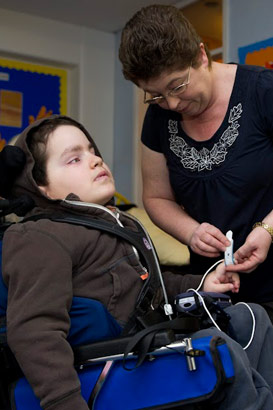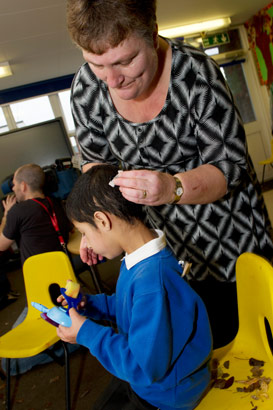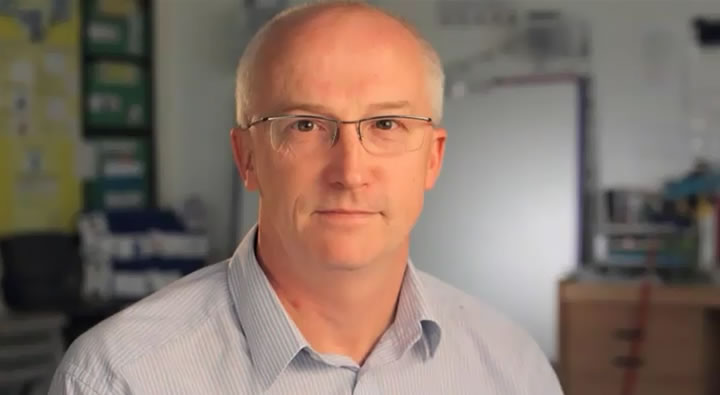
Visual impairment (VI) and hearing impairment (HI) are specialised fields
and advice should be sought from the trained staff at your school, from
your local authority, or independent trained peripatetic teacher.
Vision and the other senses tend to work closely together, so vision is
sometimes described as the 'integrating' sense (McLinden and McCall, 2002).
We will look to see where a noise has come from to put it in perspective;
a smell of burning will visually direct us to its likely source; we will
visually check the unexpected touch to our leg to see the cat brushing against
it. Vision allows us to makes sense of the other senses.
However, this is not to say that vision is the most important sense, just
that no single sense can fully compensate for the loss of another. For children
with both visual and hearing impairment, seek the services of Sense. They
are very experienced with PMLD.

Pupils' multiple impairments will not be confined to what is visually obvious, such as paraplegia, quadriplegia and asymmetric
body postures. There is an equal likelihood of internal difficulties for pupils, such as scoliosis, aspiration, hip and
arm joints loosening over time for those who are not weight bearing and/or have limited use of limbs, or problems with internal
organs, especially the liver, kidneys and heart.
Those with cerebral palsy are likely to experience extremes of spasticity (hypertonia) while, rett syndrome girls are more
likely to experience severe hypotonia. Those with PMLD will
have a considerably increased chance of experiencing epileptic episodes (Ayers, 2006); Johnson and Parkinson (2002) note
that epilepsy is a symptom of an underlying problem in a person's brain that can affect learning.
- Never position the child facing any light source, or you may just appear as a glowing blur;
- Make sure that any light source is behind the child;
- Try to dampen the glare from desktops, as reflected light can be a source of confusion;
- Use dark objects on a light background and vice versa. For example, when making a cake, put the flour and sugar in dark bowls, but raisins and chocolate in white bowls;
- An unfussy room is a focused room. Don't change displays too often, keep your rooms tidy and simple, and don't move furniture around if you don't have to as it can confuse;
- Try to dress yourself in clear single colours and avoid dramatic changes to the way you dress – you want children to look at you, not at your clothes;
- Never assume the child can see you clearly. They may be able to, but if we assume that they can't, we will try to compensate by, for example, giving touch cues to our presence. These additional cues will only aid communication, interaction and understanding.
For hearing, the basic questions to ask are:
- Does the child have a hearing impairment?
If so, what kind? - Does the child have problems with high-pitched or low-pitched sounds? Usually, it's low-pitched sounds. Therefore, men might need to be conscious of enunciating clearly and slowly.
- If you're doing side-by-side work such as, for example, helping
the child to eat or drink,
which is the child's best side to be on?
There are considerable variations of specific condition and degree of
impairment in hearing.
Watch the video clip and listen to education audiologist Graham Groves
talk about his work.
things to remember (1)

- Just because a child has good physical health, it doesn't mean they can see and hear well, since they may have one or more perceptual difficulties. That is, as with those on the autistic spectrum, the message that goes through to the brain may get skewed, and/or they may have a particular sensitivity to light and sound. Remember that perceptual problems and visual impairment will also affect the hearing, particularly in one's ability to locate a noise;
- Sharp, shiny surfaces will rebound noise just as much as they rebound light, and soft surfaces help to pinpoint sound better;
- Most importantly, we must always be aware that most sensory confusion is caused by people;
- Speak clearly, slowly and use as little language as possible as appropriate to the child's developmental stage;
- Most of all, do not cross-talk;
- Do not create unnecessary or unfocused noise such as background music. Just because it might help us concentrate on menial tasks, it doesn't mean that it helps those who may well have difficulties with concentration. By all means use music to introduce sessions, or when it's relevant to what you're teaching such as a story or a music lesson, but remember the rule of working through a single sensory channel where possible.

McLinden, M. and McCall, S. (2002) Learning Through Touch, London: David Fulton.
Sacks, S.Z. (1998) Educating Students Who Have Visual Impairments
with Other Disabilities in Sacks, S.Z. and Silberman R.K. (eds) Educating
Students Who Have Visual Impairments with Other Disabilities, Baltimore:
Brookes.
